How to use passWhenTestingAnEmptyMap method of org.amshove.kluent.tests.collections.ShouldBeEmptyShould class
Best Kluent code snippet using org.amshove.kluent.tests.collections.ShouldBeEmptyShould.passWhenTestingAnEmptyMap
ShouldBeEmptyShould.kt
Source: ShouldBeEmptyShould.kt
...18 val sequence = emptySequence<String>()19 sequence.shouldBeEmpty()20 }21 @Test22 fun passWhenTestingAnEmptyMap() {23 val map = mapOf<Int, String>()24 map.shouldBeEmpty()25 }26 @Test27 fun failWhenTestingANonEmptyArray() {28 assertFails { arrayOf("Hi").shouldBeEmpty() }29 }30 @Test31 fun failWhenTestingANonEmptyIterable() {32 assertFails { listOf("Hi").shouldBeEmpty() }33 }34 @Test35 fun failWhenTestingANonEmptySequence() {36 assertFails { sequenceOf("Hi").shouldBeEmpty() }...passWhenTestingAnEmptyMap
Using AI Code Generation
1 val shouldBeEmptyShould = ShouldBeEmptyShould()2 shouldBeEmptyShould.passWhenTestingAnEmptyMap()3 val shouldBeEmptyShould = ShouldBeEmptyShould()4 shouldBeEmptyShould.passWhenTestingAnEmptySequence()5 val shouldBeEmptyShould = ShouldBeEmptyShould()6 shouldBeEmptyShould.passWhenTestingAnEmptySet()7 val shouldBeEmptyShould = ShouldBeEmptyShould()8 shouldBeEmptyShould.passWhenTestingAnEmptyString()9 val shouldBeEmptyShould = ShouldBeEmptyShould()10 shouldBeEmptyShould.failWhenTestingANonEmptyArray()11 val shouldBeEmptyShould = ShouldBeEmptyShould()12 shouldBeEmptyShould.failWhenTestingANonEmptyCollection()13 val shouldBeEmptyShould = ShouldBeEmptyShould()14 shouldBeEmptyShould.failWhenTestingANonEmptyList()15 val shouldBeEmptyShould = ShouldBeEmptyShould()16 shouldBeEmptyShould.failWhenTestingANonEmptyMap()17 val shouldBeEmptyShould = ShouldBeEmptyShould()18 shouldBeEmptyShould.failWhenTestingANonEmptySequence()19 val shouldBeEmptyShould = ShouldBeEmptyShould()20 shouldBeEmptyShould.failWhenTestingANonEmptySet()passWhenTestingAnEmptyMap
Using AI Code Generation
1fun passWhenTestingAnEmptyMap() {2 val emptyMap = mapOf()3 emptyMap.shouldBeEmpty()4}5fun passWhenTestingAnEmptySet() {6 val emptySet = setOf()7 emptySet.shouldBeEmpty()8}9fun passWhenTestingAnEmptyString() {10 emptyString.shouldBeEmpty()11}12fun failWhenTestingANonEmptyArray() {13 val nonEmptyArray = arrayOf(1, 2, 3)14 assertFails { nonEmptyArray.shouldBeEmpty() }15}16fun failWhenTestingANonEmptyCollection() {17 val nonEmptyCollection = listOf(1, 2, 3)18 assertFails { nonEmptyCollection.shouldBeEmpty() }19}20fun failWhenTestingANonEmptyMap() {21 val nonEmptyMap = mapOf(1 to "one", 2 to "two", 3 to "three")22 assertFails { nonEmptyMap.shouldBeEmpty() }23}24fun failWhenTestingANonEmptySet() {25 val nonEmptySet = setOf(1, 2, 3)26 assertFails { nonEmptySet.shouldBeEmpty() }27}28fun failWhenTestingANonEmptyString() {29 assertFails { nonEmptyString.shouldBeEmpty() }30}Blogs
Check out the latest blogs from LambdaTest on this topic:
I routinely come across test strategy documents when working with customers. They are lengthy—100 pages or more—and packed with monotonous text that is routinely reused from one project to another. Yawn once more— the test halt and resume circumstances, the defect management procedure, entrance and exit criteria, unnecessary generic risks, and in fact, one often-used model replicates the requirements of textbook testing, from stress to systems integration.
Web applications continue to evolve at an unbelievable pace, and the architecture surrounding web apps get more complicated all of the time. With the growth in complexity of the web application and the development process, web application testing also needs to keep pace with the ever-changing demands.
API (Application Programming Interface) is a set of definitions and protocols for building and integrating applications. It’s occasionally referred to as a contract between an information provider and an information user establishing the content required from the consumer and the content needed by the producer.
Technical debt was originally defined as code restructuring, but in today’s fast-paced software delivery environment, it has evolved. Technical debt may be anything that the software development team puts off for later, such as ineffective code, unfixed defects, lacking unit tests, excessive manual tests, or missing automated tests. And, like financial debt, it is challenging to pay back.
Automation Testing Tutorials
Learn to execute automation testing from scratch with LambdaTest Learning Hub. Right from setting up the prerequisites to run your first automation test, to following best practices and diving deeper into advanced test scenarios. LambdaTest Learning Hubs compile a list of step-by-step guides to help you be proficient with different test automation frameworks i.e. Selenium, Cypress, TestNG etc.
LambdaTest Learning Hubs:
- JUnit Tutorial
- TestNG Tutorial
- Webdriver Tutorial
- WebDriverIO Tutorial
- Protractor Tutorial
- Selenium 4 Tutorial
- Jenkins Tutorial
- NUnit Tutorial
- Jest Tutorial
- Playwright Tutorial
- Cypress Tutorial
- PyTest Tutorial
YouTube
You could also refer to video tutorials over LambdaTest YouTube channel to get step by step demonstration from industry experts.
Most used method in ShouldBeEmptyShould
- passWhenTestingAnEmptyArray
- passWhenTestingAnEmptyIterable
- passWhenTestingAnEmptySequence
- passWhenTestingAnEmptyMap
- failWhenTestingANonEmptyArray
- failWhenTestingANonEmptyIterable
- failWhenTestingANonEmptySequence
- failWhenTestingANonEmptyMap
- passWhenTestingAPrimitiveIntegerArrayWhichIsEmpty
- failWhenTestingAPrimitiveIntegerArrayWhichIsNotEmpty
- passWhenTestingAPrimitiveLongArrayWhichIsEmpty
- failWhenTestingAPrimitiveLongArrayWhichIsNotEmpty
- passWhenTestingAPrimitiveShortArrayWhichIsEmpty
- failWhenTestingAPrimitiveShortArrayWhichIsNotEmpty
- passWhenTestingAPrimitiveDoubleArrayWhichIsEmpty
- failWhenTestingAPrimitiveDoubleArrayWhichIsNotEmpty
- passWhenTestingAPrimitiveFloatArrayWhichIsEmpty
- failWhenTestingAPrimitiveFloatArrayWhichIsNotEmpty
- passWhenTestingAPrimitiveByteArrayWhichIsEmpty
- failWhenTestingAPrimitiveByteArrayWhichIsNotEmpty
- passWhenTestingAPrimitiveCharArrayWhichIsEmpty
- failWhenTestingAPrimitiveCharArrayWhichIsNotEmpty
- passWhenTestingAPrimitiveBooleanArrayWhichIsEmpty
- failWhenTestingAPrimitiveBooleanArrayWhichIsNotEmpty
Try LambdaTest Now !!
Get 100 minutes of automation test minutes FREE!!



